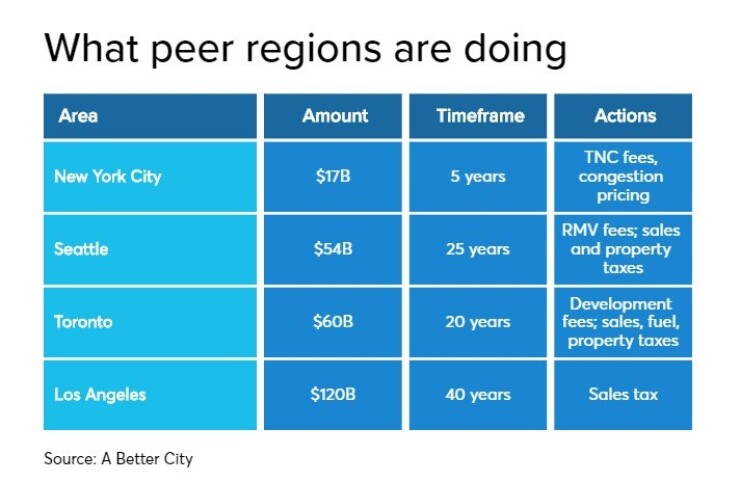BOSTON – Massachusetts faces a transportation and congestion crisis that may jeopardize its economic viability,
“We are reaching a tipping point on congestion,” David Panagore, chief administrative officer of the Massachusetts Bay Transportation Authority, said at the commonwealth’s ninth annual investor conference at the Boston Convention & Exhibition Center.

Many options, funding and otherwise, are on the table. They range from tolling highways to expanding commuter rail, long a transit stepchild.
Gov. Charlie Baker has sent to the state legislature an $18 billion transportation
Separately, the state Department of Transportation has released its $18 billion, five-year capital program for 2020 to 2024, which includes about $8 billion for the MBTA, which it oversees.
The MBTA, which operates Boston’s regional mass transit, also answers to the Fiscal Management and Control Board, the latter created after record snow in the winter of 2015 paralyzed parts of the system.
Local media glare on the “T,” as locals call the system, has intensified. The Boston Globe’s Spotlight Team published a five-part series on the region’s gridlock, while television stations have run reports on everything from derailments to transit executives going off the job during working hours.
“It’s a perfect storm,” said Greg Sullivan, research director at think tank Pioneer Institute and a former state inspector general. “Gov. Baker, transportation secretary [Stephanie] Pollack, the Senate president, the House speaker and assorted local mayors and other leaders are saying ‘we have an emergency.'
“This is an opportunity for Massachusetts to find out how to ameliorate the problem.”
Transportation investment has lagged behind Boston’s growth, which has been fueled by an innovation-economy boom in the capital city’s Seaport District.
“Greater Boston’s economy is facing a triple threat — the nation’s worst traffic, unreliable transit and acute climate impacts,” A Better City said.
Moody's Analytics projects Greater Boston’s growth will continue through 2040 in population, jobs, and housing units, even though the cost of doing business exceeds that of other Northeast and knowledge-economy regions. The cost is 20% greater than the national metropolitan average.
Point A-to-Point B problems threaten to stunt such growth. According to a survey of 600 registered voters by nonprofit MassINC Polling Group, about one-quarter of full-time employees the past few months said the problem could prompt them to relocate.

“This can become a competitiveness issue If you start to connect the dots,” said Michael Goodman, executive director of the Public Policy Center at the University of Massachusetts, Dartmouth. “Obviously we trade on our wonderful institutions. But if we don’t have the talent, those institutions lose the fuel that has driven the innovation economy here.
“I know there’s a lot of good thinking going on around transportation, but I think if we don’t start yielding results, then we’re going to start to see that kind of out-migration churn if we find ourselves either lagging the national performance or experiencing a recession.”
The new capital program “is making up for lost time and deferred maintenance, while increasing capacity and dramatically improving system reliability,” said Michael Heffernan, secretary of the Executive Office for Administration and Finance.
The 2020-2024 plan funds new trains for the Red and Orange lines on Boston’s subways, where existing cars are so old that some replacement parts are no longer available. It also backstops the light-rail Green Line extension from Cambridge to Somerville, as part of a federally mandated settlement related to the Big Dig megaproject, and a new South Coast commuter rail line from Boston to New Bedford and Fall River, using freight-only and abandoned rail lines.
Baker’s bill underscores rebuilding and modernizing assets; enhanced mobility options; support for municipalities; and accelerating capital delivery through public private partnerships and alternative project delivery methods, such as design-build-finance-operate-maintain. It also calls for design-build authority for small projects.
Accelerating capital spending is paramount for the T, which left an estimated $1 billion on the table from 2016 to 2018.
“The MBTA has problems spending their capital money, just like New York,” Sullivan said. “Boston and New York are twin cities in that regard.”
The bill would fund the $1.25 billion
DOT also intends to convert nearby Soldiers Field Road along the river to an elevated viaduct.
Another funding item in the bill is a $368 million overhaul of several access roads to the
The 84-year-old bridges are the only two road links connecting the Cape with the rest of Massachusetts.
A Better City said Baker’s bond bill doesn't go far enough.
The business group called for “roadway pricing” — tolls beyond the current Turnpike mechamism — with some near state borders; an 11.5-cent increase in the gas tax to 35.5 cents per gallon; and an increase in fees including those on Uber and Lyft, plus eliminating an auto trade-in loophole.
An 11.5-cent gas tax increase would raise Massachusetts to 11th in the nation from 32nd. The state would trail Connecticut’s 42 cents, but surpass Rhode Island’s 34 cents. New England peers Vermont, Maine and New Hampshire set the rate at 31, 30 and 22.2 cents, respectively.
In addition to the immediate need to fix what’s broken, state officials are still studying further route expansion, including the extension of the Blue Line subway from Wonderland station in Revere to Lynn, five miles north.
Such a move, MassDOT said in its

“That’s right on the bull’s eye,” Sullivan said,
Heffernan acknowledged that funding is but one component in transit mobility management. Challenges range from finding the right contracting firms to diverting residents and commuters around roadway and transit construction. Getting people out of their cars will require reliable transit options.
“Investments must therefore be strategic, well-planned and synchronized, and they need to allow the commonwealth to continue to move forward without limiting the public’s ability to reach travel destinations," he said.
“There is no silver bullet or easy fix for our transportation challenges.”





